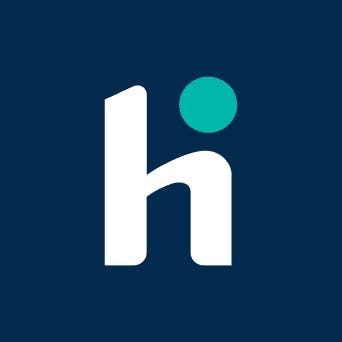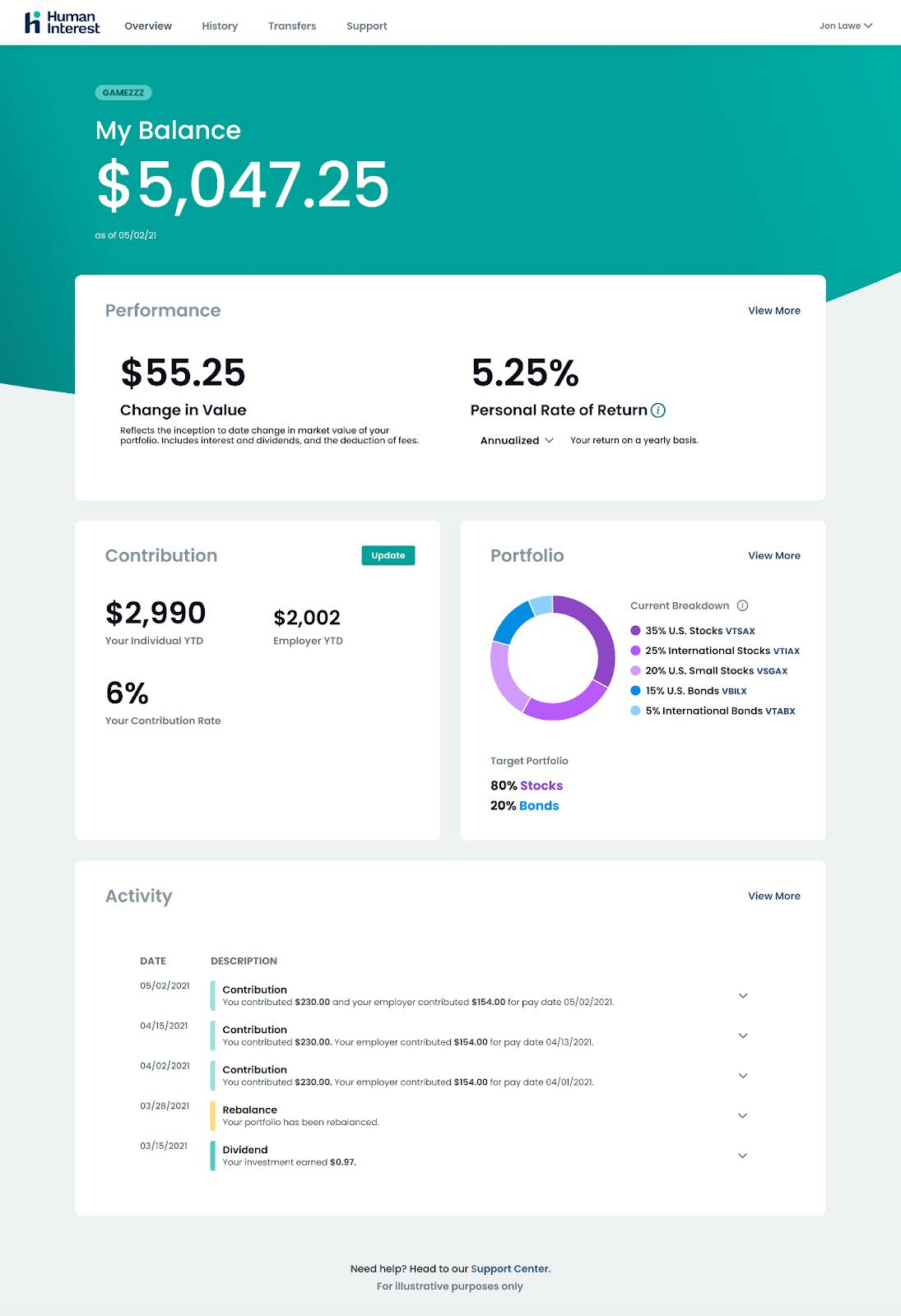
Revenue
$84.50M
2023
Valuation
$1.33B
2024
Growth Rate (y/y)
85%
2024
Funding
$700.00M
2024
Revenue
Click here for access to our Human Interest model. All Sacra estimates from public information.
Sacra estimates that Human Interest hit roughly $85M in annually recurring revenue (ARR) at the end of 2023, up 80% from $47M in 2022.
Valuation
Human Interest is valued at $1.33 billion following its Series E funding round in 2024, co-led by Marshall Wace and Baillie Gifford. Based on 2021 revenue of $25M and $1B valuation of $1B (from its 2021 Series D), Human Interest traded at a 40x revenue multiple. The company has raised over $700M in total funding across multiple rounds, including primary and secondary financings. BlackRock joined as a minority investor in January 2023, adding to a roster of prominent investors including SoftBank Vision Fund 2 and NewView Capital.
Business Model
Human Interest charges businesses on a subscription basis for access to their 401(k) plan management—between $120/mo (Essentials plan) and $180/mo (Concierge plan), plus a $4 to $8 fee per eligible employee on the plan.
They also get roughly 15% of their revenue from their 0.5% take rate on AUM, of which they have about $2B—that fee is charged to the employee’s account, while the SaaS fee above is charged to the business’s account.
Human Interest’s customer acquisition funnel relies on two sources—partnerships with 400+ payroll providers and outbound sales.
Human Interest has a large team (700+ people) and a large sales team with a focus on calling SMBs to get them to signup for or roll over a 401(k) plan.
Product

Human Interest’s product is a mix of SaaS in the front and services on the back-end.
A SaaS dashboard allows employees to check their balance, see their YTD and overall rate of return, modify their contribution, and initiate rollovers or withdrawals.
On the back-end, people manually manage the process of transferring funds or rolling them over, using 401(k) services from Matrix Trust Company.
Human Interest syncs all 401(k) contributions and information to the company’s payroll processor, they process contributions, and handle all compliance testing and paperwork to the IRS.
Competition
Human Interest operates in a competitive landscape of retirement plan providers that includes traditional financial services companies like Fidelity and Vanguard, as well as other SaaS/services businesses like Guideline.
Human Interest differentiates itself from more legacy competitors with a focus on ease of access for employees (via their SaaS portal) as well as the different pricing structure. While legacy providers charge employers 1% to 2% of their AUM per year, Human Interest charges a flat monthly fee, a $4-8 per-employee fee, and 0.5% of AUM per year.
Where companies like Fidelity and Vanguard have the upper hand today is at IPO—because 401(k) assets are declared on the S-1, companies will often ‘graduate’ to a Fidelity or Vanguard as they move to go public.
There is some overlap between Human Interest’s business and wealth management fintechs like Betterment and Wealthfront. These fintechs offer broader investment services for individual investors, including tax-efficient portfolio management, goal-based planning, and access to alternative investments—they also have IRA products. However, so far they are mostly differentiated because these services don’t have their own 401(k) programs.
TAM Expansion
A few key TAM expansion opportunities from our research:
Horizontal expansion
Human Interest has line of sight into all kinds of tax-advantaged retirement savings vehicles that do not require a mandated middleman—like the IRA, SEP, and HSA markets.
There are various markets where the government’s involvement in regulating it—like the market for 529 college savings plans—means that the economics are unfavorable for a company like Human Interest to get involved. If Human Interest were to get into the 529 market, for example, they would have to pay each state 25-50 basis points for nothing.
Catching up to Fidelity & Vanguard
Zooming out from where we are today, Human Interest’s opportunity is still well over 1,000x from where they are today.
Human Interest serves about 400,000 plan participants and 14,000 SMBs. Fidelity’s 401(k) serves 22,000 employers representing 32M+ individual employees—aka Human Interest serves about 1% as many people as Fidelity.
On AUM, Human Interest’s $2B under management is only .02% of the overall $7.3 trillion market for 401(k) assets in the United States.
Risks
Reliance on payroll providers: Human Interest relies heavily on partnerships with payroll providers for customer acquisition because Human Interest needs the kind of clean data that comes from a pay stub in order to do the data-intensive work of managing a 401(k) plan.
If those payroll providers were to their offer 401(k) plans, it might put payroll providers at odds with 401(k) providers like Human Interest and shut that distribution channel down.
Funding Rounds
|
|
||||||||||||||||||
|
||||||||||||||||||
|
|
||||||||||||||||||
|
||||||||||||||||||
|
|
||||||||||||||||||
|
||||||||||||||||||
|
|
||||||||||||||||||
|
||||||||||||||||||
|
|
||||||||||||||||||
|
||||||||||||||||||
| View the source Certificate of Incorporation copy. |
News
DISCLAIMERS
This report is for information purposes only and is not to be used or considered as an offer or the solicitation of an offer to sell or to buy or subscribe for securities or other financial instruments. Nothing in this report constitutes investment, legal, accounting or tax advice or a representation that any investment or strategy is suitable or appropriate to your individual circumstances or otherwise constitutes a personal trade recommendation to you.
This research report has been prepared solely by Sacra and should not be considered a product of any person or entity that makes such report available, if any.
Information and opinions presented in the sections of the report were obtained or derived from sources Sacra believes are reliable, but Sacra makes no representation as to their accuracy or completeness. Past performance should not be taken as an indication or guarantee of future performance, and no representation or warranty, express or implied, is made regarding future performance. Information, opinions and estimates contained in this report reflect a determination at its original date of publication by Sacra and are subject to change without notice.
Sacra accepts no liability for loss arising from the use of the material presented in this report, except that this exclusion of liability does not apply to the extent that liability arises under specific statutes or regulations applicable to Sacra. Sacra may have issued, and may in the future issue, other reports that are inconsistent with, and reach different conclusions from, the information presented in this report. Those reports reflect different assumptions, views and analytical methods of the analysts who prepared them and Sacra is under no obligation to ensure that such other reports are brought to the attention of any recipient of this report.
All rights reserved. All material presented in this report, unless specifically indicated otherwise is under copyright to Sacra. Sacra reserves any and all intellectual property rights in the report. All trademarks, service marks and logos used in this report are trademarks or service marks or registered trademarks or service marks of Sacra. Any modification, copying, displaying, distributing, transmitting, publishing, licensing, creating derivative works from, or selling any report is strictly prohibited. None of the material, nor its content, nor any copy of it, may be altered in any way, transmitted to, copied or distributed to any other party, without the prior express written permission of Sacra. Any unauthorized duplication, redistribution or disclosure of this report will result in prosecution.